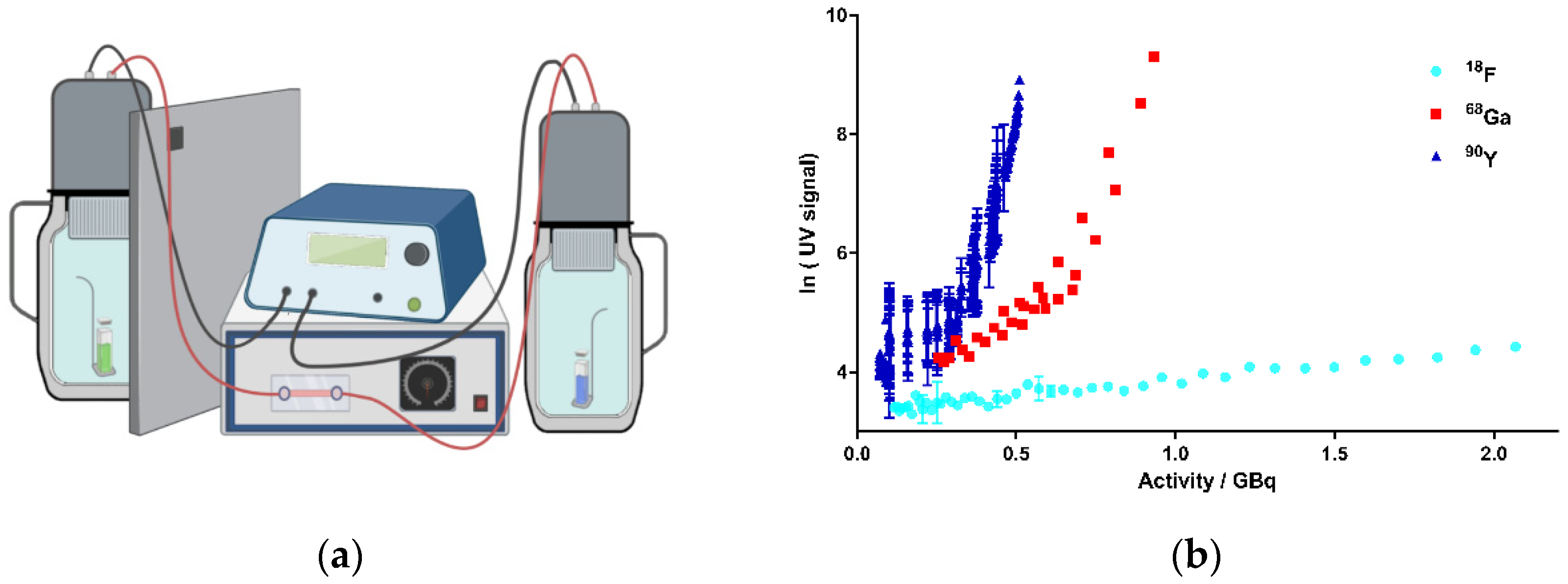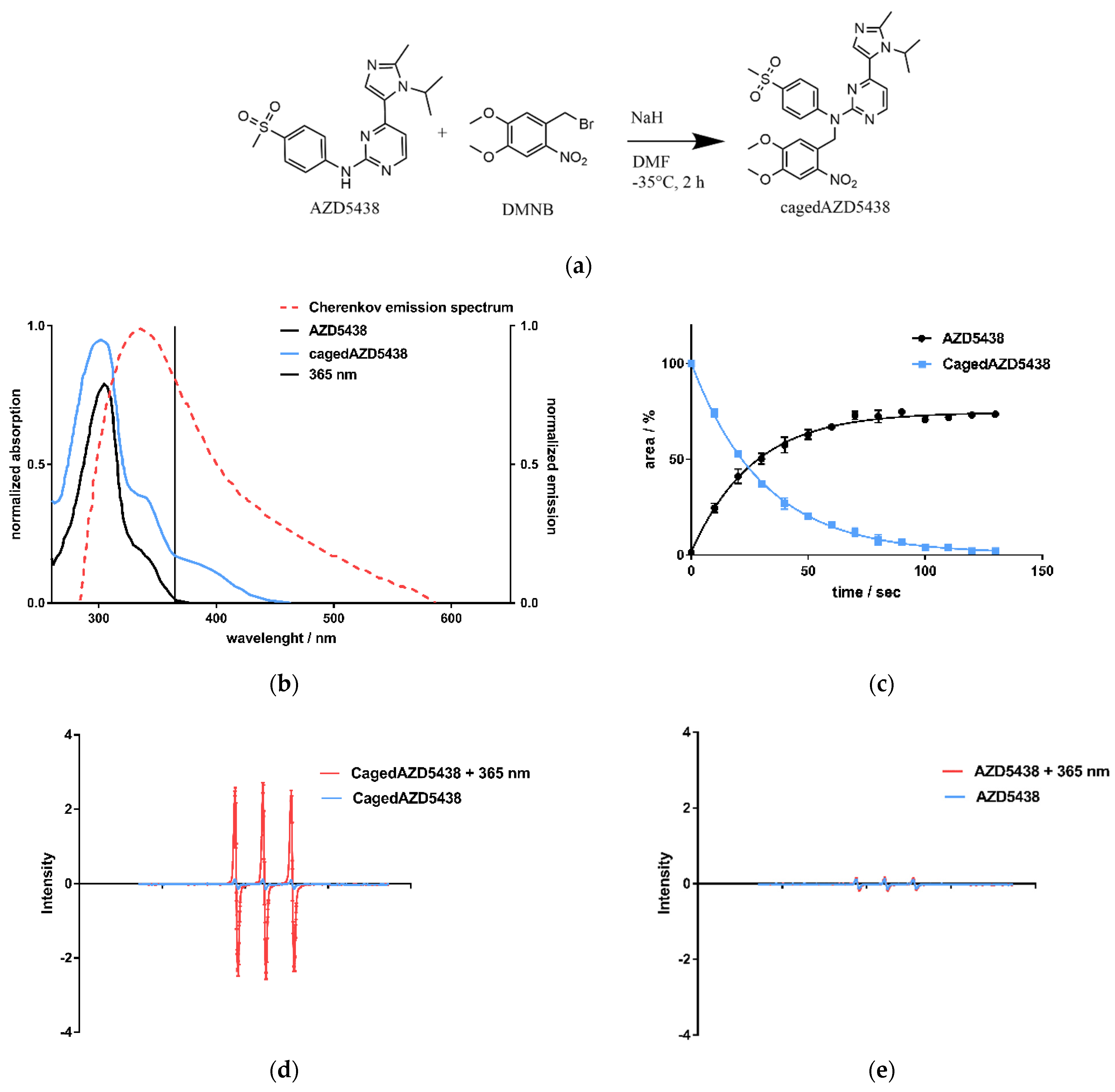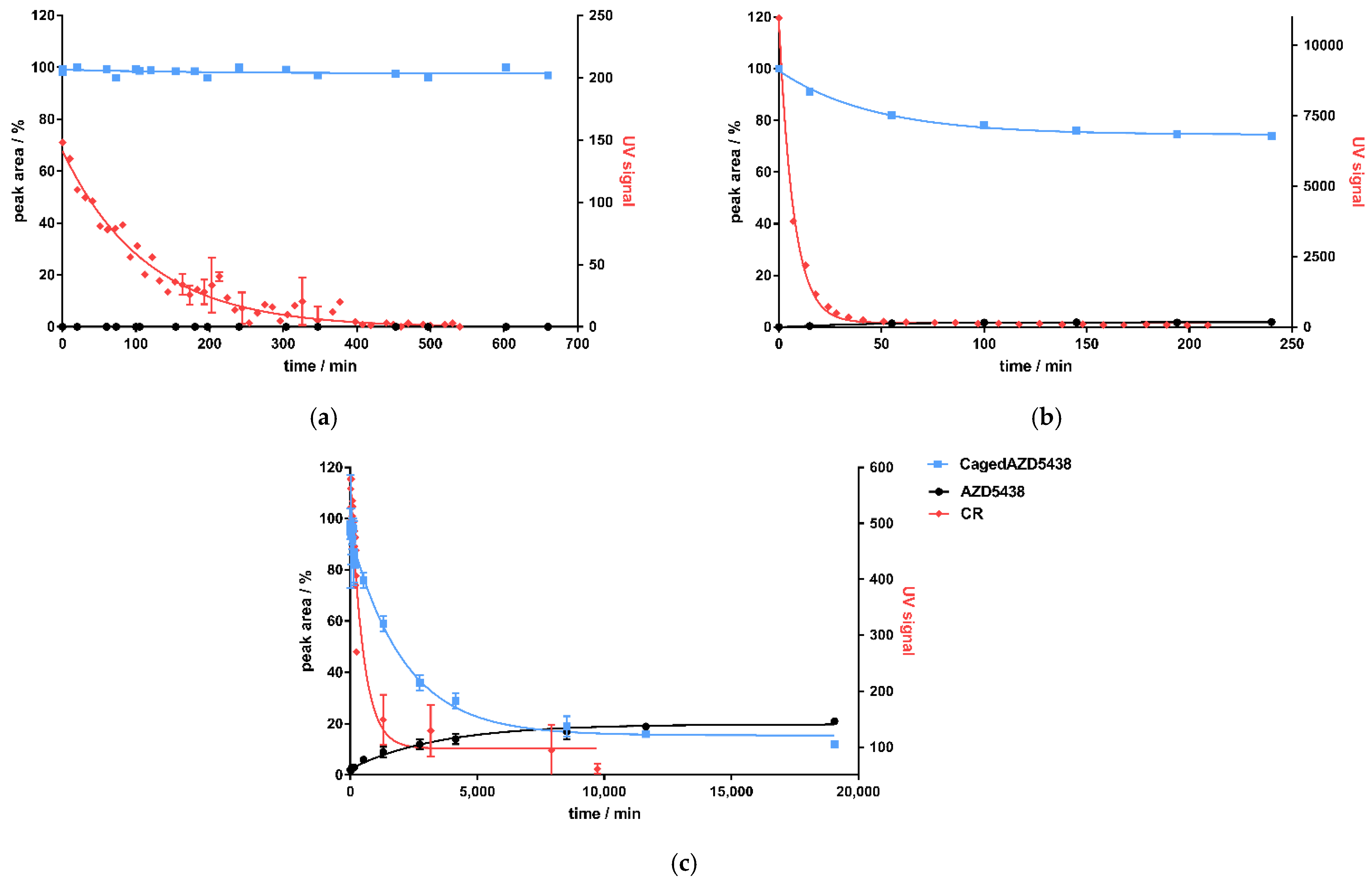Photopharmacological Applications for Cherenkov Radiation Generated by Clinically Used Radionuclides
Abstract
:1. Introduction
2. Results and Discussion
2.1. Verification of CR Generated by the Decay of Nuclides in an Aqueous Solution
2.2. Activation of a Caged Photoresponsive Compound by Cherenkov Radiation as Model System
2.3. 18Fluor
2.4. 68Gallium
2.5. 90Yttrium
3. Conclusions
Supplementary Materials
Author Contributions
Funding
Institutional Review Board Statement
Informed Consent Statement
Data Availability Statement
Conflicts of Interest
References
- Huggins, D.J.; Sherman, W.; Tidor, B. Rational Approaches to Improving Selectivity in Drug Design. J. Med. Chem. 2012, 55, 1424–1444. [Google Scholar] [CrossRef]
- Mayer, G.; Heckel, A. Biologically Active Molecules with a “Light Switch”. Angew. Chem. Int. Ed. 2006, 45, 4900–4921. [Google Scholar] [CrossRef] [PubMed]
- Klán, P.; Šolomek, T.; Bochet, C.G.; Blanc, A.; Givens, R.; Rubina, M.; Popik, V.; Kostikov, A.; Wirz, J. Photoremovable Protecting Groups in Chemistry and Biology: Reaction Mechanisms and Efficacy. Chem. Rev. 2012, 113, 119–191. [Google Scholar] [CrossRef] [PubMed]
- Ellis-Davies, G.C.R. Caged compounds: Photorelease technology for control of cellular chemistry and physiology. Nat. Methods 2007, 4, 619–628. [Google Scholar] [CrossRef] [PubMed] [Green Version]
- D’Orazio, J.; Jarrett, S.; Amaro-Ortiz, A.; Scott, T. UV Radiation and the Skin. Int. J. Mol. Sci. 2013, 14, 12222–12248. [Google Scholar] [CrossRef] [Green Version]
- Matsumura, Y.; Ananthaswamy, H.N. Toxic effects of ultraviolet radiation on the skin. Toxicol. Appl. Pharmacol. 2004, 195, 298–308. [Google Scholar] [CrossRef]
- Gentile, M. Cell cycle arrest and apoptosis provoked by UV radiation-induced DNA damage are transcriptionally highly divergent responses. Nucleic Acids Res. 2003, 31, 4779–4790. [Google Scholar] [CrossRef] [Green Version]
- Phan, T.G.; Bullen, A. Practical intravital two-photon microscopy for immunological research: Faster, brighter, deeper. Immunol. Cell Biol. 2010, 88, 438–444. [Google Scholar] [CrossRef]
- Sternberg, E.D.; Dolphin, D.; Brückner, C. Porphyrin-based photosensitizers for use in photodynamic therapy. Tetrahedron 1998, 54, 4151–4202. [Google Scholar] [CrossRef]
- Vomasta, D.; Högner, C.; Branda, N.R.; König, B. Regulation of human carbonic anhydrase I (hCAI) activity by using a photochromic inhibitor. Angew. Chem. Int. Ed. 2008, 47, 7644–7647. [Google Scholar] [CrossRef]
- Morckel, A.R.; Lusic, H.; Farzana, L.; Yoder, J.A.; Deiters, A.; Nascone-Yoder, N.M. A photoactivatable small-molecule inhibitor for light-controlled spatiotemporal regulation of Rho kinase in live embryos. Development 2012, 139, 437–442. [Google Scholar] [CrossRef] [Green Version]
- Zindler, M.; Pinchuk, B.; Renn, C.; Horbert, R.; Döbber, A.; Peifer, C. Design, Synthesis, and Characterization of a Photoactivatable Caged Prodrug of Imatinib. ChemMedChem 2015, 10, 1335–1338. [Google Scholar] [CrossRef]
- Bliman, D.; Nilsson, J.R.; Kettunen, P.; Andréasson, J.; Grøtli, M. A Caged Ret Kinase Inhibitor and its Effect on Motoneuron Development in Zebrafish Embryos. Sci. Rep. 2015, 5, 13109. [Google Scholar] [CrossRef] [Green Version]
- Ferreira, R.; Nilsson, J.R.; Solano, C.; Andréasson, J.; Grøtli, M. Design, Synthesis and Inhibitory Activity of Photoswitchable RET Kinase Inhibitors. Sci. Rep. 2015, 5, 9769. [Google Scholar] [CrossRef] [Green Version]
- Frank, J.A.; Yushchenko, D.A.; Hodson, D.J.; Lipstein, N.; Nagpal, J.; Rutter, G.A.; Rhee, J.-S.; Gottschalk, A.; Brose, N.; Schultz, C.; et al. Photoswitchable diacylglycerols enable optical control of protein kinase C. Nat. Chem. Biol. 2016, 12, 755–762. [Google Scholar] [CrossRef] [PubMed] [Green Version]
- Wilson, D.; Li, J.W.; Branda, N.R. Visible-Light-Triggered Activation of a Protein Kinase Inhibitor. ChemMedChem 2017, 12, 284–287. [Google Scholar] [CrossRef] [PubMed]
- Schmidt, D.; Rodat, T.; Heintze, L.; Weber, J.; Horbert, R.; Girreser, U.; Raeker, T.; Bußmann, L.; Kriegs, M.; Hartke, B.; et al. Axitinib: A Photoswitchable Approved Tyrosine Kinase Inhibitor. ChemMedChem 2018, 13, 2415–2426. [Google Scholar] [CrossRef]
- Goegan, B.; Terzi, F.; Bolze, F.; Cambridge, S.; Specht, A. Synthesis and Characterization of Photoactivatable Doxycycline Analogues Bearing Two-Photon-Sensitive Photoremovable Groups Suitable for Light-Induced Gene Expression. ChemBioChem 2018, 19, 1341–1348. [Google Scholar] [CrossRef]
- Hoorens, M.W.H.; Ourailidou, M.E.; Rodat, T.; van der Wouden, P.E.; Kobauri, P.; Kriegs, M.; Peifer, C.; Feringa, B.L.; Dekker, F.J.; Szymanski, W. Light-controlled inhibition of BRAFV600E kinase. Eur. J. Med. Chem. 2019, 179, 133–146. [Google Scholar] [CrossRef] [PubMed]
- Trads, J.B.; Hüll, K.; Matsuura, B.S.; Laprell, L.; Fehrentz, T.; Görldt, N.; Kozek, K.A.; Weaver, C.D.; Klöcker, N.; Barber, D.M.; et al. Sign Inversion in Photopharmacology: Incorporation of Cyclic Azobenzenes in Photoswitchable Potassium Channel Blockers and Openers. Angew. Chem. Int. Ed. 2019, 58, 15421–15428. [Google Scholar] [CrossRef] [PubMed]
- Jelley, J.V. British Journal of Applied Physics Cerenkov radiation and its applications. Br. J. Appl. Phys. 1955, 6, 227. [Google Scholar] [CrossRef]
- Elrick, R.H.; Parker, R.P. The use of Cerenkov radiation in the measurement of β-emitting radionuclides. Int. J. Appl. Radiat. Isot. 1968, 19, 263–271. [Google Scholar] [CrossRef]
- Ran, C.; Zhang, Z.; Hooker, J.; Moore, A. In vivo photoactivation without "light": Use of Cherenkov radiation to overcome the penetration limit of light. Mol. Imaging Biol. 2012, 14, 156–162. [Google Scholar] [CrossRef] [Green Version]
- Kotagiri, N.; Sudlow, G.P.; Akers, W.J.; Achilefu, S. Breaking the depth dependency of phototherapy with Cerenkov radiation and low-radiance-responsive nanophotosensitizers. Nat. Nanotechnol. 2015, 10, 370–379. [Google Scholar] [CrossRef] [Green Version]
- Bulin, A.-L.; Truillet, C.; Chouikrat, R.; Lux, F.; Frochot, C.; Amans, D.; Ledoux, G.; Tillement, O.; Perriat, P.; Barberi-Heyob, M.; et al. X-ray-Induced Singlet Oxygen Activation with Nanoscintillator-Coupled Porphyrins. J. Phys. Chem. C 2013, 117, 21583–21589. [Google Scholar] [CrossRef]
- Lioret, V.; Bellaye, P.-S.; Arnould, C.; Collin, B.; Decréau, R.A. Dual Cherenkov Radiation-Induced Near-Infrared Luminescence Imaging and Photodynamic Therapy toward Tumor Resection. J. Med. Chem. 2020, 63, 9446–9456. [Google Scholar] [CrossRef] [PubMed]
- Cline, B.; Delahunty, I.; Xie, J. Nanoparticles to mediate X-ray-induced photodynamic therapy and Cherenkov radiation photodynamic therapy. Wiley Interdiscip. Rev. Nanomed. Nanobiotechnol. 2019, 11, e1541. [Google Scholar] [CrossRef] [PubMed]
- Schneider, P.B. Determination of specific activity of 32P-labeled compounds using Cerenkov counting. J. Nucl. Med. Off. Publ. Soc. Nucl. Med. 1971, 12, 14–16. [Google Scholar]
- Al-Masri, M.S. Cerenkov counting technique. J. Radioanal. Nucl. Chem. Artic. 1996, 207, 205–213. [Google Scholar] [CrossRef]
- Rowińska, L.; Jaskólska, H.; Radwan, M. Aktivitätsbestimmung von Phosphor-32 mit Hilfe der Tscherenkow -Strahlung. Isot. Isot. Environ. Health Stud. 2008, 11, 223–225. [Google Scholar] [CrossRef]
- Axelsson, J.; Davis, S.C.; Gladstone, D.J.; Pogue, B.W. Cerenkov emission induced by external beam radiation stimulates molecular fluorescence. Med. Phys. 2011, 38, 4127–4132. [Google Scholar] [CrossRef] [Green Version]
- Compton, A.H. A Quantum Theory of the Scattering of X-rays by Light Elements. Phys. Rev. 1923, 21, 483–502. [Google Scholar] [CrossRef]
- Dinesh Mayani, D. Proton therapy for cancer treatment. J. Oncol. Pharm. Pract. 2010, 17, 186–190. [Google Scholar] [CrossRef] [PubMed]
- Tanha, K.; Pashazadeh, A.M.; Pogue, B.W. Review of biomedical Čerenkov luminescence imaging applications. Biomed. Opt. Express 2015, 6, 3053. [Google Scholar] [CrossRef] [Green Version]
- Volkert, W.A.; Hoffman, T.J. Therapeutic Radiopharmaceuticals. Chem. Rev. 1999, 99, 2269–2292. [Google Scholar] [CrossRef]
- Livechart-Table of Nuclides-Nuclear Structure and Decay Data. Available online: https://www-nds.iaea.org/relnsd/vcharthtml/VChartHTML.html#dcy1 (accessed on 20 May 2021).
- Montgomery, C.W. Electron capture. In Geochemistry; Kluwer Academic Publishers: Dordrecht, The Netherlands, 1998; pp. 189–190. [Google Scholar]
- Baum, R.P. Nuklearmedizinische Diagnostik und Therapiekontrolle neuroendokriner Tumore (NET) mittels Rezeptor-PET/CT und Szintigraphie. Fortschr. Röntgenstr 2005, 177. [Google Scholar] [CrossRef]
- Krause, B.J.; Beyer, T.; Bockisch, A.; Delbeke, D.; Kotzerke, J.; Minkov, V.; Reiser, M.; Willich, N. FDG-PET/CT in der Onkologie. Leitlinie. Nukl. Nucl. Med. 2007, 46, 291–301. [Google Scholar] [CrossRef] [PubMed]
- Biersack, H.-J.; Ezziddin, S.; Risse, J.; Bender, H.; Palmedo, H. Therapie mit Radioisotopen in der Onkologie. Palliative und kurative Ansätze. Schmerz 2005, 19, 9–17. [Google Scholar] [CrossRef] [PubMed]
- Thieme. Nuklearmedizin: 122 Tabellen; Büll, U., Bares, R., Eds.; Thieme: Stuttgart, Germany, 2001. [Google Scholar]
- Haddad, T.; Fard-Esfahani, A.; Vali, R. A review of pediatric neuroendocrine tumors, their detection, and treatment by radioisotopes. Nucl. Med. Commun. 2020, 19, 589–608. [Google Scholar] [CrossRef]
- Bahrami-Samani, A.; Anvari, A.; Jalilian, A.R.; Shirvani-Arani, S.; Yousefnia, H.; Aghamiri, M.R.; Ghannadi-Maragheh, M. Production, Quality Control and Pharmacokinetic Studies of (177)Lu-EDTMP for Human Bone Pain Palliation Therapy Trials. Iran. J. Pharm. Res. 2012, 11, 137–144. [Google Scholar] [PubMed]
- Kessel, K.; Seifert, R.; Weckesser, M.; Roll, W.; Humberg, V.; Schlack, K.; Bögemann, M.; Bernemann, C.; Rahbar, K. Molecular analysis of circulating tumor cells of metastatic castration-resistant Prostate Cancer Patients receiving 177Lu-PSMA-617 Radioligand Therapy. Theranostics 2020, 10, 7645–7655. [Google Scholar] [CrossRef] [PubMed]
- Fischer, M.; Mödder, G. Radionuclide therapy of inflammatory joint diseases. Nucl. Med. Commun. 2002, 23, 829–831. [Google Scholar] [CrossRef]
- Bort, G.; Gallavardin, T.; Ogden, D.; Dalko, P.I. From One-Photon to Two-Photon Probes: “Caged” Compounds, Actuators, and Photoswitches. Angew. Chem. Int. Ed. 2013, 52, 4526–4537. [Google Scholar] [CrossRef]
- Corrie, J.E.T.; Furuta, T.; Givens, R.; Yousef, A.L.; Goeldner, M. Photoremovable Protecting Groups Used for the Caging of Biomolecules. In Dynamic Studies in Biology: Phototriggers, Photoswitches and Caged Biomolecules; Goeldner, M., Givens, R., Eds.; Wiley-VCH: Weinheim, Germany, 2005; pp. 1–94. [Google Scholar]
- Šolomek, T.; Mercier, S.; Bally, T.; Bochet, C.G. Photolysis of ortho-nitrobenzylic derivatives: The importance of the leaving group. Photochem. Photobiol. Sci. 2012, 11, 548. [Google Scholar] [CrossRef] [Green Version]
- Shchemelinin, I.; Sefc, L.; Necas, E. Protein kinases, their function and implication in cancer and other diseases. Folia Biol. 2006, 52, 81–100. [Google Scholar]
- Schwartz, P.A.; Murray, B.W. Protein kinase biochemistry and drug discovery. Bioorganic Chem. 2011, 39, 192–210. [Google Scholar] [CrossRef] [PubMed]
- Malumbres, M. Cyclin-dependent kinases. Genome Biol. 2014, 15, 122. [Google Scholar] [CrossRef] [PubMed] [Green Version]
- Asghar, U.; Witkiewicz, A.K.; Turner, N.C.; Knudsen, E.S. The history and future of targeting cyclin-dependent kinases in cancer therapy. Nat. Rev. Drug Discov. 2015, 14, 130–146. [Google Scholar] [CrossRef] [PubMed] [Green Version]
- Fischer, P.M. Approved and Experimental Small-Molecule Oncology Kinase Inhibitor Drugs: A Mid-2016 Overview. Med. Res. Rev. 2017, 37, 314–367. [Google Scholar] [CrossRef] [PubMed] [Green Version]
- Byth, K.F.; Thomas, A.; Hughes, G.; Forder, C.; McGregor, A.; Geh, C.; Oakes, S.; Green, C.; Walker, M.; Newcombe, N.; et al. AZD5438, a potent oral inhibitor of cyclin-dependent kinases 1, 2, and 9, leads to pharmacodynamic changes and potent antitumor effects in human tumor xenografts. Mol. Cancer Ther. 2009, 8, 1856–1866. [Google Scholar] [CrossRef] [Green Version]
- Super-Kamiokande Official Website. Available online: http://www-sk.icrr.u-tokyo.ac.jp/sk/index-e.html (accessed on 26 July 2021).
- Buschendorf, F. Messung der Kosmischen Strahlung—Myonenlebensdauer und-Rate; Gymnasium der Stadt Rahden: Rahden, Germany, 2012. [Google Scholar]
- Conti, M.; Eriksson, L. Physics of pure and non-pure positron emitters for PET: A review and a discussion. EJNMMI Phys. 2016, 3, 1379. [Google Scholar] [CrossRef] [PubMed] [Green Version]
- The luminescence of irradiated transparent media and the Čerenkov effect-I. The luminescence of aqueous solutions of radioactive isotopes. In Proceedings of the Royal Society of London—Series A: Mathematical and Physical Sciences Website; Royal Society: London, UK, 1997; Volume 216, pp. 90–102.
- Mougeot, X. Erratum: Reliability of usual assumptions in the calculation of β and ν spectra. Phys. Rev. C 2015, 92. [Google Scholar] [CrossRef] [Green Version]
- Mougeot, X. Reliability of usual assumptions in the calculation of β and ν spectra. Phys. Rev. C 2015, 91, 455. [Google Scholar] [CrossRef] [Green Version]
- Kirschner, S.; Döbber, A.; Krebs, M.; Witt, C.; Hartke, B.; Peifer, C. The Impact of Electronic Effects on Photolysis: A Model Study on the 4,5-Dimethoxy-2-nitrobenzyl Caged N-Phenylpyrimidine-2-amine Scaffold. ChemPhotoChem 2020, 4, 638–643. [Google Scholar] [CrossRef]
- Rodat, T.; Krebs, M.; Döbber, A.; Jansen, B.; Steffen-Heins, A.; Schwarz, K.; Peifer, C. Restricted suitability of BODIPY for caging in biological applications based on singlet oxygen generation. Photochem. Photobiol. Sci. 2020, 19, 1319–1325. [Google Scholar] [CrossRef]
- Alegrı́a, A.E.; Ferrer, A.; Santiago, G.; Sepúlveda, E.; Flores, W. Photochemistry of water-soluble quinones. Production of the hydroxyl radical, singlet oxygen and the superoxide ion. J. Photochem. Photobiol. A Chem. 1999, 127, 57–65. [Google Scholar] [CrossRef]





| Nuclide | Emax/MeV | Emean/MeV Iβ(abs) * | Type of Radiation (Branching Ratio) | Indication | |
|---|---|---|---|---|---|
| 68Ga | 67.71 min | 1.9 | 0.84 (87.72%) | ec ß+ (100%) | Diagnostics, PET/CT [38] |
| 18F | 109.77 min | 0.63 | 0.25 (96.73%) | ec ß+ (100%) | Diagnostics, PET/CT [39] |
| 153Sm | 46.28 h | 0.81 | 0.23 (49.40%) | ß− (100%) | Bone metastases [40] |
| 90Y | 64.00 h | 2.28 | 0.93 (99.99%) | ß− (100%) | Neuroendocrine tumors, pleural and peritoneal carcinosis, hepatocellular and cholangiocellular carcinoma, liver metastases, rheumatoid arthritis and activated arthrosis, malignant lymphomas of B cells [40,41] |
| 186Re | 3.72 d | 1.07 | 0.36 (70.99%) | ß− (92.33%) | Bone metastases, rheumatoid arthritis, activated arthrosis [41] |
| 177Lu | 6.64 d | 0.50 | 0.15 (79.44%) | ß− (100%) | Neuroendocrine tumors [42], bone pain palliation [43], metastatic castration-resistant prostate cancer [44] |
| 131I | 8.03 d | 0.61 | 0.19 (89.60%) | ß− (100%) | Neuroendocrine tumors, pleural and peritoneal carcinosis [40], thyroid autonomy, Graves’ disease, goiter, thyroid cancer, pheochromocytoma, liver metastases, liver cell and cholangiocellular carcinoma [41] |
| 169Er | 9.39 d | 0.35 | 0.10 (55.50%) | ß− (100%) | Rheumatoid arthritis [45] |
| 32P | 14.27 d | 1.71 | 0.70 (100.00%) | ß− (100%) | Polycythemia vera [40,41], essential thrombocythemia [41] |
| Sample | Radioactivity/MBq | Solvent | Total Volume/mL | Compound Concentration/μM |
|---|---|---|---|---|
| 1 | 20 | 10% DMSO in water | 1 | 50 |
| 2 | 200 | 10% DMSO in water | 1 | 50 |
| 3 | 150 | 10% DMSO in water | 1 | 50 |
| 4 | 107 | 50% MeOH in water | 0.4 | 125 |
| 5 | 120 | 50% MeOH in water | 0.4 | 125 |
| Sample | Radioactivity/MBq | Solvent | Total Volume/mL | Compound Concentration/μM |
|---|---|---|---|---|
| 1 | 300 | 20% DMSO in 1 M HCl | 1.25 | 50 |
| 2 | 900 | 20% DMSO in 1 M HCl | 1.25 | 50 |
| 3 | 900 | 20% DMSO in 1 M HCl with 0.4 M NH4Ac | 1.25 | 50 |
| 4 | 900 | 20% DMSO in 1 M HCl with 5 M HEPES | 1.25 | 50 |
| 5 | 900 | 20% DMSO in 1 M HCl | 3 | 50 |
| 6 | – | 20% DMSO in 1 M HCl and 69Ga | 1.25 | 50 |
| Sample | Radioactivity/MBq | Solvent | Total Volume/mL | Compound Concentration/μM |
|---|---|---|---|---|
| 1 | 419 | 20% DMSO in 0.04 M HCl | 1.25 | 50 |
| 2 | – | 20% DMSO in 0.04 M HCl | 1.25 | 50 |
Publisher’s Note: MDPI stays neutral with regard to jurisdictional claims in published maps and institutional affiliations. |
© 2021 by the authors. Licensee MDPI, Basel, Switzerland. This article is an open access article distributed under the terms and conditions of the Creative Commons Attribution (CC BY) license (https://creativecommons.org/licenses/by/4.0/).
Share and Cite
Krebs, M.; Döbber, A.; Rodat, T.; Lützen, U.; Zhao, Y.; Zuhayra, M.; Peifer, C. Photopharmacological Applications for Cherenkov Radiation Generated by Clinically Used Radionuclides. Int. J. Mol. Sci. 2021, 22, 9010. https://doi.org/10.3390/ijms22169010
Krebs M, Döbber A, Rodat T, Lützen U, Zhao Y, Zuhayra M, Peifer C. Photopharmacological Applications for Cherenkov Radiation Generated by Clinically Used Radionuclides. International Journal of Molecular Sciences. 2021; 22(16):9010. https://doi.org/10.3390/ijms22169010
Chicago/Turabian StyleKrebs, Melanie, Alexander Döbber, Theo Rodat, Ulf Lützen, Yi Zhao, Maaz Zuhayra, and Christian Peifer. 2021. "Photopharmacological Applications for Cherenkov Radiation Generated by Clinically Used Radionuclides" International Journal of Molecular Sciences 22, no. 16: 9010. https://doi.org/10.3390/ijms22169010
APA StyleKrebs, M., Döbber, A., Rodat, T., Lützen, U., Zhao, Y., Zuhayra, M., & Peifer, C. (2021). Photopharmacological Applications for Cherenkov Radiation Generated by Clinically Used Radionuclides. International Journal of Molecular Sciences, 22(16), 9010. https://doi.org/10.3390/ijms22169010







